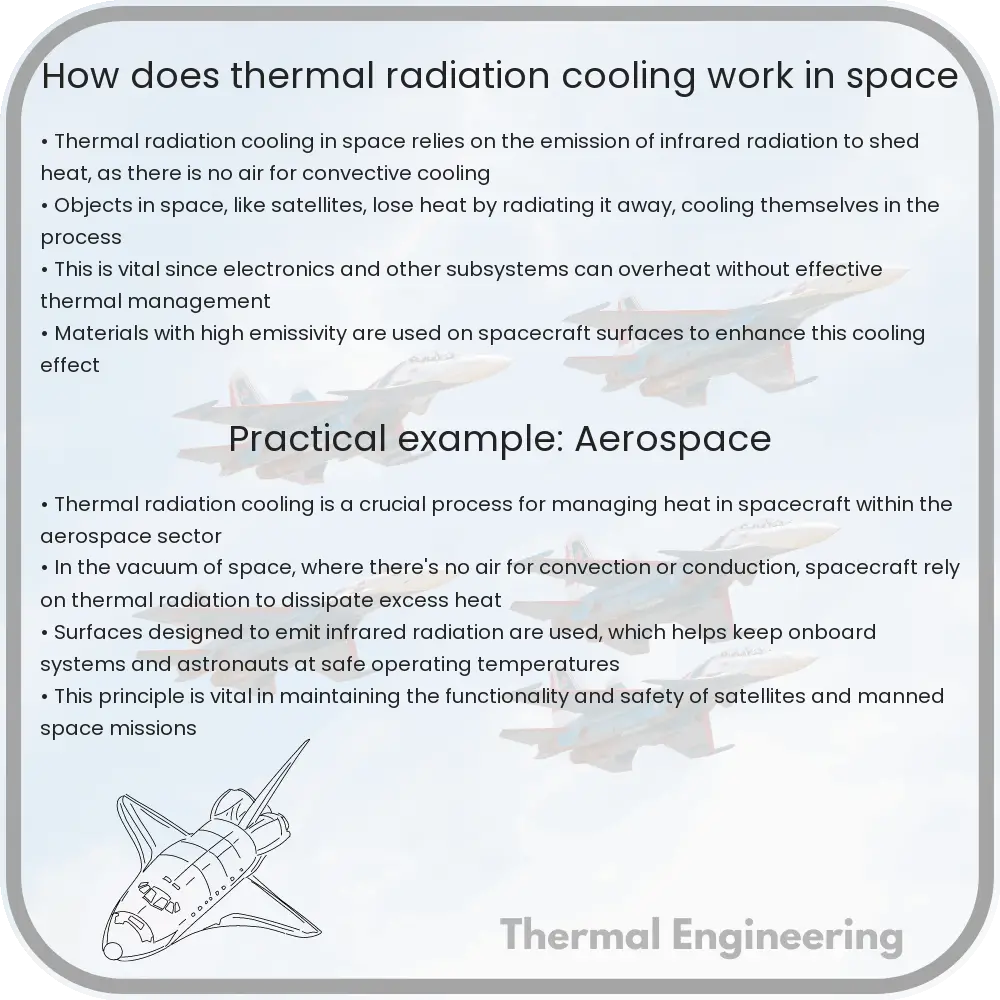Learn how thermal radiation cooling effectively manages heat in spacecraft and satellites operating in the vacuum of space, utilizing principles of heat transfer and innovative engineering solutions.

Understanding Thermal Radiation Cooling in Space
Thermal radiation cooling is a critical process used in the thermoregulation of spacecraft and satellites. Unlike on Earth, where heat can be transferred by convection or conduction in the atmosphere, space presents unique challenges due to its vacuum environment. This article explores how thermal radiation cooling functions as an effective solution for managing heat in the harsh conditions of space.
Basics of Heat Transfer
Firstly, it’s important to understand the three modes of heat transfer: conduction, convection, and radiation. Conduction is the transfer of heat through a solid material by direct contact. Convection is the transfer of heat by the movement of fluids (liquids or gases). However, in space, with the absence of air or any other fluid, conduction and convection are not viable methods for heat dispersion. This leaves radiation as the primary mode of heat transfer.
Thermal radiation is the emission of electromagnetic waves, which can carry energy from a hotter object to a cooler one without the need for a medium (like air). This makes it ideally suited for space applications.
How Thermal Radiation Cooling Works
Every object at a temperature above absolute zero emits thermal radiation. In the context of spacecraft, internal mechanisms and equipment generate heat which must be managed to avoid overheating and to maintain optimal performance. Here’s how thermal radiation cooling is employed:
- Surface Emissivity: Spacecraft are equipped with external surfaces that have high emissivity. Emissivity is a measure of a material’s ability to emit absorbed energy. Materials with high emissivity can more effectively radiate heat away.
- Thermal Radiators: These are specifically designed components that increase the surface area from which heat can be radiated into space. They are usually positioned in a manner that maximizes exposure to the coldness of space, away from the sun and other heat sources.
- Surface Color and Coating: The color and type of coating applied to the exterior of a spacecraft can significantly affect its ability to radiate heat. Lighter colors and specialized coatings are typically used to maximize emissivity.
Mathematical Description
The rate at which a body radiates heat can be described by the Stefan-Boltzmann Law, which is given by the equation:
\[ P = \sigma * A * T^4 \]
where:
- P is the power radiated per unit area,
- \(\sigma\) is the Stefan-Boltzmann constant (\(5.67 \times 10^{-8} \text{ Wm}^{-2}\text{K}^{-4}\)),
- A is the surface area,
- T is the absolute temperature in Kelvin.
This equation highlights that the power radiated per unit area from a hot body increases dramatically with temperature, indicating that even small changes in the temperature of spacecraft equipment can significantly impact its thermal radiation.
Challenges and Solutions
Despite its effectiveness, thermal radiation cooling in space has challenges. The significant difference in temperature between the sunlit and shadowed parts of a spacecraft can cause temperature instability. Advanced thermal control systems, such as louvers, heat pipes, and thermal insulators, are used to manage these variations and ensure stable operations.
In summary, thermal radiation cooling is a vital function in space technology, enabling spacecraft to manage internal heat efficiently in the vacuum of space. By emitting heat as infrared radiation, spacecraft maintain their internal systems at operational temperatures, thus safeguarding sensitive instrumentation and ensuring the success of the mission.
Conclusion
As space exploration progresses, the role of engineering in understanding and enhancing thermal radiation cooling will continue to grow. This form of cooling not only exemplifies a practical application of thermodynamics in a challenging environment but also symbolizes human ingenuity in overcoming the obstacles of space exploration.